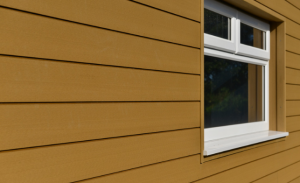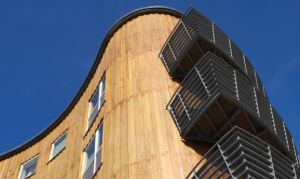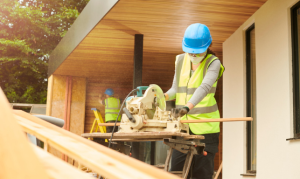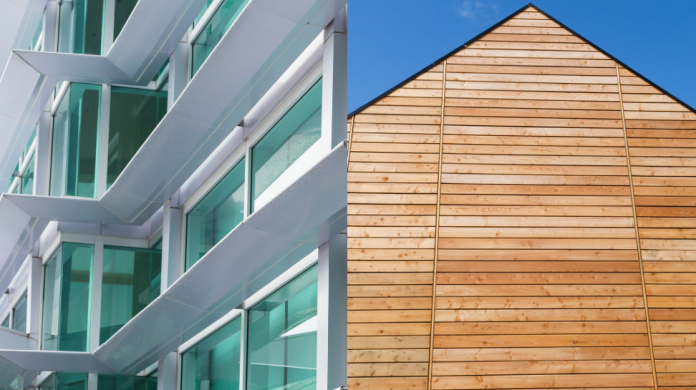Table of Contents
Cladding is an excellent, cost-effective way to give your exterior walls a makeover in a matter of minutes. It can also prolong their lifespan while offering insulation. These key factors should include cost, upkeep, aesthetics, and durability. Wooden cladding and composite cladding are two popular choices, but how do they differ in the most crucial components?
You have a selection of exterior cladding materials to choose from, whether it’s for a residential or commercial building. When determining which one is best for you, it’s crucial to consider a few key factors.
First, let’s define both composite and wood cladding:
Composite Cladding

Composite cladding is a manufactured cladding material that you can use to clad the exterior walls of your property. This cladding material is produced from recycled materials, including wood fibre and plastic, and that’s why it’s commonly referred to as “plastic wood cladding” by homeowners. Composite cladding is incredibly popular in the UK today. For instance, you purchase it online from composite warehouse panels.
Wood Cladding

Unlike composite cladding, which is made up of wood and plastic, wood or timber cladding is made entirely of timber. Wood cladding comes in two varieties. There’s pressure-treated wood and hardwood cladding. Pressure-treated wood cladding is produced with chemicals that make it last longer, whereas hardwood is chemical-free.
Here are some key differences between wood and composite cladding:
Durability

Composite wood cladding is generally longer-lasting than wood cladding. Hardwood cladding, the more durable type of wood cladding, which is made of 100% timber, can’t match the resilience and longevity of composite cladding. The other type of wood cladding, pressure-treated wood cladding, has been chemically treated to make it stronger, but it is still not as long-lasting as hardwood and composite cladding.
The truth is that both hardwood and softwood deteriorate with age, and they face numerous problems such as termites and rodent infestations, moisture absorption, decay, warping, and splintering. On the other hand, composite cladding is more long-lasting than wood because it is manmade and consists of wood fibre, polymers, and other materials. Composite cladding is resistant to decay, moisture, ultraviolet rays, pest control risks, rot, splintering, and warping.
Maintenance
Composite cladding is also the lowest maintenance option. Natural wood may look gorgeous, but it might be vulnerable to pest attacks if it isn’t sealed, stained, or painted regularly. Sanding and painting are also necessary for cosmetic upkeep, as wood cladding may fade if not maintained properly.
There’s no need to sand or paint composite cladding because it doesn’t fade. It remains visually appealing for a long period without requiring any maintenance and does not require termite coating. When it comes to maintenance, composite cladding cleaning tips simply needs to be cleaned with water once in a while.
Cost

Composite cladding is costlier than wood cladding. However, if you factor in maintenance expenses at your overall cost, the composite cladding may be more cost-saving than the wood cladding. This is due to the fact that composite cladding has a longer lifespan and requires less maintenance.
Because composite cladding is so resilient and long-lasting, it might last as long as your property. Composite cladding does not require painting, staining, or treating like wood cladding. Using composite cladding is not only cost-saving but time and labour saving.
Aesthetics
Wooden cladding is beautiful and distinctive in texture, but it only has a timber appearance unless it is coated over. Because composite cladding is manufactured rather than a harvested material, you can choose from a variety of colours, patterns, and styles. With wood cladding, you have a limited range of styles to choose from, while composite cladding has a wide array of looks that can suit your home’s aesthetics and design.
These days, composite cladding can be designed to resemble wood in terms of surface texture and colour. In fact, it may be hard to tell the difference between natural timber and the most natural-looking composite wood. This allows you to clad the exteriors of your home in the natural wood look you like without the rigorous maintenance that real wood requires.
Conclusion
Your exterior cladding provides an extra layer of “skin” to your home. As a result, it has a dual purpose: it is both decorative and protective, protecting your home from the elements.
So which is better between the wood cladding and composite cladding?
Because of its weather-resistant and pest-deterrent properties, composite cladding is considered a much better option than the wood cladding. Composite is also a versatile material, with a wide choice of colours and styles to choose from. Although composite cladding may initially be more expensive than traditional wood cladding, it is likely to save money in the long run because of the lower cost of maintenance.


